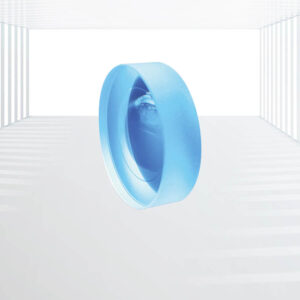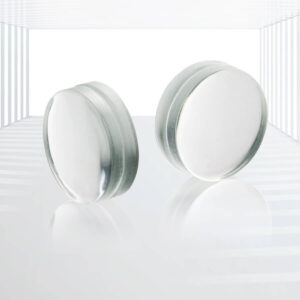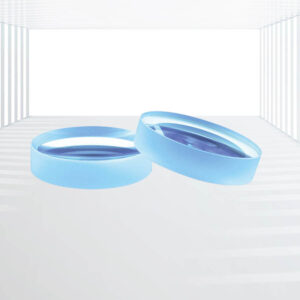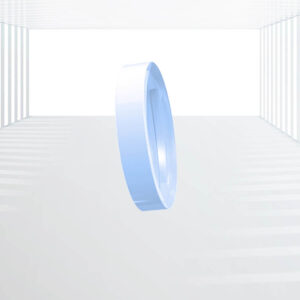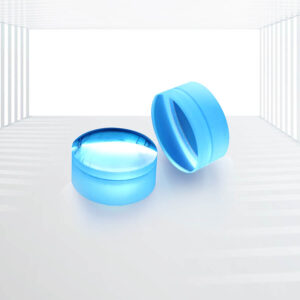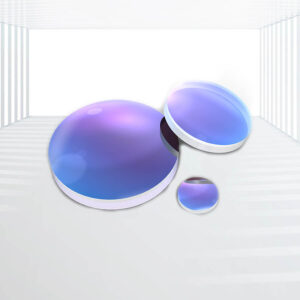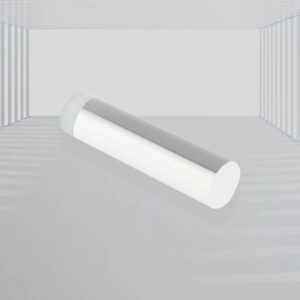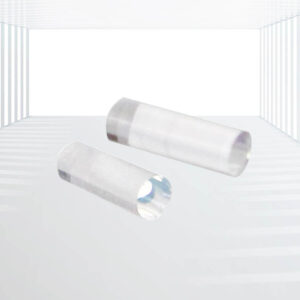λ10 UV Fused Silica Plano-concave Lenses
Excellent UV Transmission:
UV fused silica, also known as UV-grade fused silica, is known for its high transmission in the UV range, typically from 190 nm to 2600 nm, depending on the coating. This makes it an ideal material for plano-concave lenses designed to work in the UV spectrum.
Low Fluorescence and Laser-Induced Damage Threshold:
UV fused silica exhibits virtually no laser-induced fluorescence, ensuring that the material does not emit light when excited by UV radiation. This is crucial for applications where fluorescence could interfere with measurements or imaging.
It also has a high laser-induced damage threshold, allowing it to withstand high-intensity laser beams without degrading.
Surface Quality and Accuracy:
The λ/10 surface irregularity specification indicates that the surface deviations from a perfect shape are kept to within one-tenth of the wavelength of light used, typically at 633 nm. This level of precision ensures minimal wavefront distortions and optical aberrations.
- The lenses may also have other surface quality specifications, such as a 40-20 scratch-dig rating, which guarantees a smooth surface with minimal defects.
Material Homogeneity and Stability:
UV fused silica has better homogeneity and a lower coefficient of thermal expansion than some other optical materials, such as N-BK7. This results in less variation in optical properties across the lens and improved stability under changing temperature conditions.
Diverging Ability:
As plano-concave lenses, they have a negative focal length, enabling them to diverge collimated beams. This property is useful in applications where beam expansion or projection is required.
Customizable Coatings:
UV fused silica plano-concave lenses can be coated with various antireflection (AR) coatings optimized for specific wavelength ranges, including those in the UV spectrum. This minimizes reflections and maximizes transmission over the desired wavelengths.
Wide Range of Sizes and Focal Lengths:
These lenses are available in various diameters and focal lengths, allowing for flexibility in system design. This ensures that there is a suitable lens for a wide range of applications.
Compatibility and Mounting Options:
UV fused silica plano-concave lenses are often compatible with standard optical mounts and components, facilitating integration into existing optical systems.
Applications: Laser scanners, remote sensing, imaging instruments, fiber lasers, interferometers, and other optical systems, etc.
A Plano-Concave Lens is a bulk optical singlet with one flat side and one concave side, resulting in a negative focal length and negative spherical aberration. These lenses diverge collimated light beams from a virtual focus and are used to spread collimated light beams, increase the focal length of an optical instrument, and balance spherical aberration, thereby improving image quality. They are often incorporated into Galilean beam expanders and other optical systems to reduce spherical aberration, coma, and distortion, especially when the absolute conjugate ratio (objective distance: image distance) is greater than 5:1.
UV Fused Silica is the amorphous form of Silicon Dioxide. It features superior transmission in the UV region and can be utilized for wavelengths ranging from Ultraviolet (UV) to Near-Infrared (NIR) spectrum. Apart from its excellent UV transmission, UV-grade fused silica glass excels in low thermal expansion, great chemical inertia, high optical homogeneity, and the absence of fluorescence under UV radiation. Compared with N-BK7, UV Fused Silica is more reliable in high-temperature environments and has better transmittance to ultraviolet light.
Specifications:
| Lens Form | Plano-convex Lens |
| Irregularity(@632.8nm) | λ/10 |
| Surface Quality (Scratch/Dig) | 10/5 |
| Clear Aperture | 90% |
| Centering Error | ≤2 arc min |
| Diameters(mm) | 12.7mm, 25.4mm, or custom |
| Protective Chamfer | 0.2mmx45° |
| Material | Custom: Corning HPFS glass series, JGS1 Stock:Corning 7980-0F, 7980-1D |
Features:
1.Excellent UV Transmission:
- UV fused silica, also known as UV-grade fused silica, is known for its high transmission in the UV range, typically from 190 nm to 2600 nm, depending on the coating. This makes it an ideal material for plano-concave lenses designed to work in the UV spectrum.
2.Low Fluorescence and Laser-Induced Damage Threshold:
- UV fused silica exhibits virtually no laser-induced fluorescence, ensuring that the material does not emit light when excited by UV radiation. This is crucial for applications where fluorescence could interfere with measurements or imaging.
- It also has a high laser-induced damage threshold, allowing it to withstand high-intensity laser beams without degrading.
3.Surface Quality and Accuracy:
- The λ/10 surface irregularity specification indicates that the surface deviations from a perfect shape are kept to within one-tenth of the wavelength of light used, typically at 633 nm. This level of precision ensures minimal wavefront distortions and optical aberrations.
- The lenses may also have other surface quality specifications, such as a 40-20 scratch-dig rating, which guarantees a smooth surface with minimal defects.
4.Material Homogeneity and Stability:
- UV fused silica has better homogeneity and a lower coefficient of thermal expansion than some other optical materials, such as N-BK7. This results in less variation in optical properties across the lens and improved stability under changing temperature conditions.
5.Diverging Ability:
- As plano-concave lenses, they have a negative focal length, enabling them to diverge collimated beams. This property is useful in applications where beam expansion or projection is required.
6.Customizable Coatings:
- UV fused silica plano-concave lenses can be coated with various antireflection (AR) coatings optimized for specific wavelength ranges, including those in the UV spectrum. This minimizes reflections and maximizes transmission over the desired wavelengths.
7.Wide Range of Sizes and Focal Lengths:
- These lenses are available in various diameters and focal lengths, allowing for flexibility in system design. This ensures that there is a suitable lens for a wide range of applications.
8.Compatibility and Mounting Options:
- UV fused silica plano-concave lenses are often compatible with standard optical mounts and components, facilitating integration into existing optical systems.
Specifications and Applications:
- Precision: High-precision lenses with irregularities of λ/10 and surface qualities of 10/5 S/D.
- Focal Lengths: Stocked UV Fused Silica plano-concave lenses range from -25mm to -300mm, with other focal lengths available upon request.
- Applications: Laser scanners, remote sensing, imaging instruments, fiber lasers, interferometers, and other optical systems.
Kingwin Optics offers both stocked and custom Plano-Concave Lenses made from Corning High Purity UV Fused Silica Glass (Corning HPFS Glass), including Corning 7980-0F and 7980-1D, or JGS1. These lenses provide excellent mechanical and chemical resilience, and can be applied to wavelengths ranging from 200-2200 nm.



